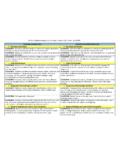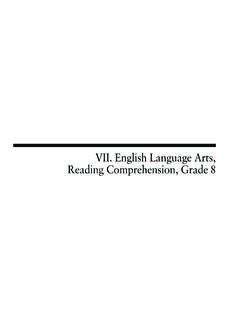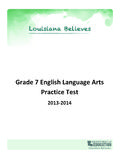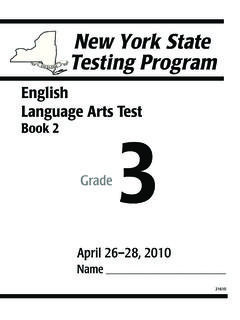Transcription of Oral Language - Virginia Department of Education
1 english standards of learning for Virginia Public Schools - January 2010 grade Three Reading continues to be a priority in third grade . Emphasis is on learning about words, reading text with fluency and expression, and learning comprehension strategies. The student will read a variety of fiction and nonfiction texts, which relate to all areas of the curriculum. The student will use effective communication skills in group activities and will present brief oral reports. Reading comprehension strategies will be applied in all subjects, with emphasis on materials that reflect the standards of learning in mathematics, science, and history and social science. The student will plan, draft, revise, and edit stories, simple explanations, and short reports. In addition, the student will gather and use information from print and electronic sources. The student also will write legibly in cursive. Oral Language The student will use effective communication skills in group activities.
2 A) Listen attentively by making eye contact, facing the speaker, asking questions, and summarizing what is said. b) Ask and respond to questions from teachers and other group members. c) Explain what has been learned. d) Use Language appropriate for context. e) Increase listening and speaking vocabularies. The student will present brief oral reports using visual media. a) Speak clearly. b) Use appropriate volume and pitch. c) Speak at an understandable rate. d) Organize ideas sequentially or around major points of information. e) Use contextually appropriate Language and specific vocabulary to communicate ideas. Reading The student will apply word-analysis skills when reading. a) Use knowledge of regular and irregular vowel patterns. b) Decode regular multisyllabic words. The student will expand vocabulary when reading. a) Use knowledge of homophones. b) Use knowledge of roots, affixes, synonyms, and antonyms.
3 C) Apply meaning clues, Language structure, and phonetic strategies. d) Use context to clarify meaning of unfamiliar words. e) Discuss meanings of words and develop vocabulary by listening and reading a variety of texts. f) Use vocabulary from other content areas. g) Use word reference resources including the glossary, dictionary, and thesaurus. 1 english standards of learning for Virginia Public Schools - January 2010 The student will read and demonstrate comprehension of fictional text and poetry. a) Set a purpose for reading. b) Make connections between previous experiences and reading selections. c) Make, confirm, or revise predictions. d) Compare and contrast settings, characters, and events. e) Identify the author s purpose. f) Ask and answer questions about what is read. g) Draw conclusions about text. h) Identify the problem and solution. i) Identify the main idea. j) Identify supporting details.
4 K) Use reading strategies to monitor comprehension throughout the reading process. l) Differentiate between fiction and nonfiction. m) Read with fluency and accuracy. The student will continue to read and demonstrate comprehension of nonfiction texts. a) Identify the author s purpose. b) Use prior and background knowledge as context for new learning . c) Preview and use text features. d) Ask and answer questions about what is read. e) Draw conclusions based on text. f) Summarize major points found in nonfiction texts. g) Identify the main idea. h) Identify supporting details. i) Compare and contrast the characteristics of biographies and autobiographies. j) Use reading strategies to monitor comprehension throughout the reading process. k) Identify new information gained from reading. l) Read with fluency and accuracy. The student will demonstrate comprehension of information from a variety of print and electronic resources.
5 A) Use encyclopedias and other reference books, including online reference materials. b) Use table of contents, indices, and charts. Writing The student will write legibly in cursive. The student will write for a variety of purposes. a) Identify the intended audience. b) Use a variety of prewriting strategies. c) Write a clear topic sentence focusing on the main idea. d) Write a paragraph on the same topic. e) Use strategies for organization of information and elaboration according to the type of writing. f) Include details that elaborate the main idea. g) Revise writing for clarity of content using specific vocabulary and information. 2 english standards of learning for Virginia Public Schools - January 2010 The student will edit writing for correct grammar, capitalization, punctuation, and spelling. a) Use complete sentences. b) Use transition words to vary sentence structure.
6 C) Use the word I in compound subjects. d) Use past and present verb tense. e) Use singular possessives. f) Use commas in a simple series. g) Use simple abbreviations. h) Use apostrophes in contractions with pronouns and in possessives. i) Use the articles a, an, and the correctly. j) Use correct spelling for frequently used sight words, including irregular plurals. The student will write a short report. a) Construct questions about the topic. b) Identify appropriate resources. c) Collect and organize information about the topic into a short report. d) Understand the difference between plagiarism and using own words. The student will use available technology for reading and writing. 3


















